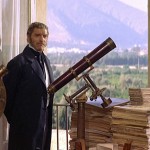Doppio premio per Dawn
Scomparso Roel Gathier
Roel Gaither, direttore dell'Istituto olandese per la Ricerca Spaziale (SRON) e presidente del Comitato di programma scientifico dell'ESA (SPC), è scomparso ieri, 15 marzo.
Gathier, nato il 31 gennaio 1953, ha lavorato dal 2000 allo SRON ed è stato nominato direttore nel 2010. Dal 2009 aveva anche rappresentato il suo paese in seno al Consiglio dell'ESA ed è stato nominato presidente del CPS dopo essere stato vice presidente dal 2011.
Italiano
Continue reading
MoSeF, molecole senza frontiere
16/03/2016
MoSeF è una rete di ricercatori, docenti, tecnici e artisti operanti in diverse istituzioni pubbliche italiane, nata per sviluppare una strategia originale per la divulgazione interdisciplinare della chimica, delle sue interrelazion... Continue reading
Tanta Italia nelle nuove infrastrutture di ricerca europee
10/03/2016
Il 10 marzo 2016, nel corso di un evento organizzato ad Amsterdam nell’ambito del semestre di presidenza dell’Unione europea dell’Olanda, il forum strategico europeo ESFRI sulle infrastrutture di ricerca ha presentato la ... Continue reading
Le strane macchie luminose di Cerere
Lo spettrografo HARPS all’Osservatorio dell’ESO di La Silla in Cile ha osservato il pianeta nano Cerere, il più grande oggetto della fascia degli asteroidi tra Marte e Giove. Il pianeta nano più vicino alla Terra sembra mostrare una propria attività interna che si manifesta attraverso la variazione di luminosità delle sue enigmatiche macchie brillanti. Lo strumento montato sul telescopio da 3,6 metri dell’ESO ha rivelato cambiamenti inaspettati nelle macchie chiare, come una maggiore luminosità durante il giorno.
Italiano
Continue reading
Proteine in microgravità
 A quota 400 chilometri, là dove vola la Stazione Spaziale Internazionale, i cristalli di proteine crescono più belli e meglio. A dirlo è uno studio giapponese appena pubblicato, che dei cristalli ha monitorato la lentissima crescita e il tasso di dissoluzione grazie alla tecnica dell’interferometria laser Continue reading
A quota 400 chilometri, là dove vola la Stazione Spaziale Internazionale, i cristalli di proteine crescono più belli e meglio. A dirlo è uno studio giapponese appena pubblicato, che dei cristalli ha monitorato la lentissima crescita e il tasso di dissoluzione grazie alla tecnica dell’interferometria laser Continue reading
A short introduction to Project Management
Il 18/03/2016Ise-Cnr - Istituto per lo studio degli ecosistemi
Largo Tonolli 50, 28922 Verbania Pallanza
Seminario di Sara Cerri e Paolo Sasso (PMI® Northern Italy Chapter, Branch Piemonte-Valle D'Aosta, Chivasso - TO)
What is a project? And w... Continue reading
Palermo scopre le sue carte d’archivio
 Viene presentato oggi l’inventario completo dell'archivio storico dell'Osservatorio Astronomico di Palermo. Le carte conservate riguardano il periodo compreso tra la direzione di Giuseppe Piazzi, il sacerdote che scoprì Cerere, fino agli anni ’70 dello scorso secolo, passando per il “Gattopardo”, ovvero il Principe di Lampedusa, valente astronomo dilettante dell'Ottocento. Per raffigurarlo al meglio, nel 1962 Luchino Visconti chiese in prestito all'Osservatorio strumentazione e carte originali Continue reading
Viene presentato oggi l’inventario completo dell'archivio storico dell'Osservatorio Astronomico di Palermo. Le carte conservate riguardano il periodo compreso tra la direzione di Giuseppe Piazzi, il sacerdote che scoprì Cerere, fino agli anni ’70 dello scorso secolo, passando per il “Gattopardo”, ovvero il Principe di Lampedusa, valente astronomo dilettante dell'Ottocento. Per raffigurarlo al meglio, nel 1962 Luchino Visconti chiese in prestito all'Osservatorio strumentazione e carte originali Continue reading

